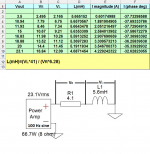using two Dayton steel inductors, which composite inductor would be "superior" ?
A high power handling 2mH inductor is desired. All are wound on the same bobbin and core.
Two 1mH in series vs two 4mH in parallel. Which if either is better and why?
A high power handling 2mH inductor is desired. All are wound on the same bobbin and core.
Two 1mH in series vs two 4mH in parallel. Which if either is better and why?
First I'd want to know whether they will be on the same core, or each on their own core which is the same type. Because 2x1mH on the same core may add up to 4mH on its own.
Each on its own core
1mH, 0.19 ohm DCR
Dayton Audio - IC181 1.0mH 18 AWG I Core Inductor
4mH, 0.44 ohm DCR
Dayton Audio - IC184 4.0mH 18 AWG I Core Inductor
1mH, 0.19 ohm DCR
Dayton Audio - IC181 1.0mH 18 AWG I Core Inductor
4mH, 0.44 ohm DCR
Dayton Audio - IC184 4.0mH 18 AWG I Core Inductor
It is interesting because the 4mH has more than double the resistance, so there is a little more leakage due to the winding size.
Your original idea, in both cases there is the same core area being used to the same overall degree. The two 1mH will be slightly more core oriented, giving you the slightly lower DCR for the same total inductance.
On the other hand, buying one 4mH inductor and taking off turns will give you the lowest resistance, but then you will then have less core.
Your original idea, in both cases there is the same core area being used to the same overall degree. The two 1mH will be slightly more core oriented, giving you the slightly lower DCR for the same total inductance.
On the other hand, buying one 4mH inductor and taking off turns will give you the lowest resistance, but then you will then have less core.
Dear freddi,
You may get the 4mH choke (cheaper) and reduce the turns to 70.7% to get 2mH, while also improving its saturation current limit to 141.4% of the original 4mH part. The new DC resistance would be 70.7% of 0.44 = 0.311 ohms, whereas using 2x1mH (uncoupled) would give 2x0.19 = 0.38ohms instead. And use steel cores only for LF, < 1kHz or thereabouts.
All the best.
You may get the 4mH choke (cheaper) and reduce the turns to 70.7% to get 2mH, while also improving its saturation current limit to 141.4% of the original 4mH part. The new DC resistance would be 70.7% of 0.44 = 0.311 ohms, whereas using 2x1mH (uncoupled) would give 2x0.19 = 0.38ohms instead. And use steel cores only for LF, < 1kHz or thereabouts.
All the best.
Last edited:
And use steel cores only for LF, < 1kHz or thereabouts.
Why is this important, what harm can it do to freqs above 1000kz?
There's something that goes by the name 'complex permeability' that may be thought of as the change in permeability (mu) with respect to frequency or rather colloquially "permeability response" for a magnetic core material.
For steel, this quantity doesn't extend much above 1 kHz (typical curve here), as it was originally meant for mains frequencies (< 100Hz). Thus, using the material above 1kHz would cause a reduced (and delayed) change in the flux density (and back-emf) with respect to applied magnetising (H) field, that would, in turn, be perceived as reduced inductance and filtering performance, along with increased core losses (heat).
For steel, this quantity doesn't extend much above 1 kHz (typical curve here), as it was originally meant for mains frequencies (< 100Hz). Thus, using the material above 1kHz would cause a reduced (and delayed) change in the flux density (and back-emf) with respect to applied magnetising (H) field, that would, in turn, be perceived as reduced inductance and filtering performance, along with increased core losses (heat).
Last edited:
perhaps the cheap and cheerful way is to accept the performance of their stock 2mH steel core inductor with its 0.33 ohm DCR and not fret.
Dayton Audio 2.0mH 18 AWG I Core Inductor Crossover Coil
What audible effects happen if one employs a steel core inductor as a high pass shunt for a compression driver? (I've seen it done with generic PA crossovers.)
Dayton Audio 2.0mH 18 AWG I Core Inductor Crossover Coil
What audible effects happen if one employs a steel core inductor as a high pass shunt for a compression driver? (I've seen it done with generic PA crossovers.)
Audible effects may show once you have saturated core so much that it no longer has its nominal inductance, rather a smaller value depending on the saturation. So, simulate FR with different L values and you should observe the probable changes.
Attachments
What part is your concern, the shunt position, the frequency, the efficient driver? I have used them that way.
I would be interested in trying steel core (vs air core) shunt with an inexpensive compression driver (13lb , 1.5" exit). Lets say I want 1200Hz/8 ohm highpass for that compression driver for experimentation with a "K-tube", would a 3rd order highpass CLC be a better choice than 2nd order electric? I can envision some interaction of the driver's Z peaks with the cap but that would be mitigated with some padding. I'm not at my regular place so don't currently have access to parts plus have lost my WT3 device.
- Home
- Loudspeakers
- Multi-Way
- using two Dayton steel inductors, which composite inductor would be "superior" ?
